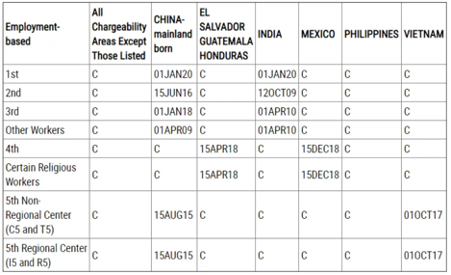Introduction to EB3 Visas
Each year, the United States of America gives out thousands of employment-based immigration visas to eligible candidates. One way to get a green card is through a U.S. company. This is referred to as EB or “employment-based” green cards. There are five different categories of EB green cards. This article will explore the Employment-Based Third Preference EB3 Visa. We’ll also discuss the differences between EB3 visa and EB1 and EB2. The EB1, EB2 and EB3 categories are similar in some way. As for EB4 and EB5, we’ll discuss those in separate articles.
Stick with us till the end, and you’ll know what an EB3 Visa is, who is eligible for it, and how to get one.

What is an EB3 Visa?
EB3 Visa stands for “Employment-Based Third Preference Category.” Eligibility turns on having a certain type of job offer from a U.S. company. In EB3 cases, a U.S. company has to ask the U.S. government to give you a green card so you can work with them. So, the first thing you need is a job offer from an American sponsor.
There are three categories of EB3 visas.
Skilled Workers
Here, you need a job offer that requires you to have at least two years of job experience or education. (Example: you have an offer to be a graphic designer that requires two years of experience.)
Professionals
In this category, you need a 4-year college degree and the job offered typically requires that degree. (Example: you have a job offer to be a mechanical engineer, which requires a 4 year degree in mechanical engineering).
Unskilled Workers
The job offered requires less than two years’ experience or education. (Example: Working in landscaping or being a nanny. This job doesn’t normally require experience or education.)
What is the difference between EB1 and EB3 visas?
EB3 visas are much easier to get than EB1s.
EB1 stands for “Employment-Based First Preference Category.” Some say this category is for “geniuses.” More precisely, the EB1 visas are for the leaders in fields of science, art, education, business, or athletics. It is divided into three subcategories:
1. Individuals in the top percentile in their field. (EB1-A visa).
2. Noncitizens outstanding researchers or professors. (EB1-B visa).
3. Employees who are “executives” or “managers” of multinational companies. (EB1-C visa).
In order to qualify for one of the EB1 classes, you must show you meet the requirements for EB1 visas.
What is the difference between EB2 and EB3 visas?
EB2 stands for “Employment-Based Second Preference Category.” The EB2 visa category is designed for individuals who advanced degrees and are exceptional or advanced in their fields. Like EB1 and EB3, EB2 is divided into three subcategories:
1. Individuals with advanced degrees with job offers requiring an advanced degree
2. Individuals with exceptional abilities, expertise, with job offers requiring this expertise in arts, sciences or business
3. National Interest Waivers (NIW) for individuals who it is in the U.S. national interest that they be allowed to come and work.
Check out our page for more information about EB2 visas.
EB3 Visa Requirements
The EB3 visa process can be confusing. Here, we try to help you understand the process, form and timelines. First, we’ll discuss the categories of EB3 visa in more detail.
Requirements to Qualify as a Skilled Worker
To prove yourself a skilled worker, you must fulfill the following requirements. You must have obtained at least two years of work experience or training as a skilled worker. This training can also be in the form of certain post-secondary education. Furthermore, no other competent worker must be available for the job within the U.S.
Lastly, a full-time permanent job offer must be present from an employer based in the United States of America. In addition, this employer has to provide a labor certification proving they have been unsuccessful in finding a U.S. citizen fit for the job.
Requirements to Qualify as EB3 Professional
You need to satisfy the following requirements to fall under the professionals’ category of the EB3 Visa.
Candidates under this category must have a bachelor’s degree from the U.S. or a foreign equivalent degree. This degree must be in the same field as the job. For example, to get an EB3 visa as an accountant you would have to have an 4 year accounting degree.
Requirements to Qualify as EB3 Unskilled Worker
To fall under the category of unskilled workers, you must be able to satisfy the following requirements.
First, you must prove the ability to partake in unskilled work. This work cannot be seasonal or temporary. It has to be permanent work.
Secondly, you must have an existing job offer from a U.S. employer who is sponsoring you. This job cannot require two or more years’ worth of training or experience; it must be less than that. This is different from the skilled and professional EB3 green card categories.
Application Process for EB3 Visa
It is your employer’s job to file a petition requesting an EB3 Visa for you. There are four major steps in the process.
1. Obtain a qualifying job offer from a U.S. employer. This is where you determine under which category you qualify: 1) Skilled Worker; 2) Professional; or 3) Unskilled Worker.
2. Your employer will need to advertise to confirm there are no U.S. workers available to fill your position. This is referred to as a labor certification and is obtained, not from immigration, but the U.S. Department of Labor.
3. Once you obtain the labor certification, you apply with the United States Citizenship and Immigration Services (USCIS). This is the form I-140
4. If USCIS approves your petition, then you can apply for your EB3 Visa (green card) either in the U.S. using a form I-485 or aboard at one of the consulates.
Timeline for an EB3 Visa
The EB3 Visa timeline depends on how many visas are available. The visa bulletin tells you when you can apply for a green card in each category.
How to check the visa bulletin for EB3 Visas
On the bulletin, check whether your country of origin is listed. If it’s not, then look under the column “All Changeability Areas Except Those Listed.”
Once you have found the right column then go to where it says “3rd.” Check the date under “3rd” category using the correct country column. If it says “C,” then you don’t have to wait for a visa. (You do have to wait for processing time.)
If the bulletin lists a month and year, then they are processing only the Form I-140 petition filed before that date. For example, if you’re from India, and we look at the chart below, then immigration is only processing EB3 visas for petitions filed before April 1, 2010

EB3 Visa Lawyer: Online Search Tool
Your EB3 visa case is complicated. There are two agencies and four to five different parts to each case. For that reason, it’s important to find an experience EB3 visa attorney to help you.
One place you can find an EB3 lawyer is through the American Immigration Lawyers Association (AILA) directory. Once you are there, use the drop down menu next to “Type of Lawyer” and choose “Business & Employment.” Contact someone in your area for a consultation on your EB3 visa.
Good luck!



